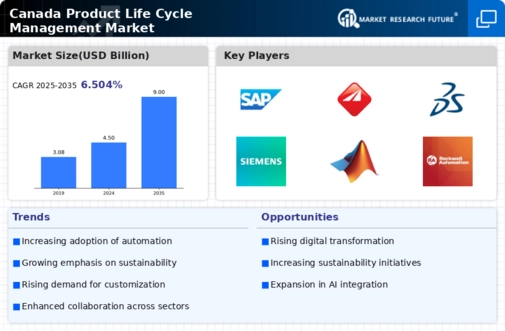The product life-cycle-management market in Canada is characterized by a dynamic competitive landscape, driven by technological advancements and increasing demand for efficient product development processes. Major players such as Siemens AG (DE), PTC Inc. (US), and Dassault Systèmes SE (FR) are at the forefront, each adopting distinct strategies to enhance their market positioning. Siemens AG (DE) emphasizes innovation through its digital twin technology, which integrates real-time data into product development, thereby streamlining operations. PTC Inc. (US) focuses on expanding its IoT capabilities, enhancing its PLM solutions to cater to the growing need for connected product ecosystems. Meanwhile, Dassault Systèmes SE (FR) leverages its 3D modeling expertise to foster collaboration across various industries, positioning itself as a leader in digital transformation within the market.
The business tactics employed by these companies reflect a concerted effort to optimize supply chains and localize manufacturing processes. The market structure appears moderately fragmented, with a mix of established players and emerging startups vying for market share. The collective influence of these key players shapes a competitive environment where innovation and customer-centric solutions are paramount, driving the evolution of product life-cycle management.
In October 2025, Siemens AG (DE) announced a strategic partnership with a leading Canadian university to develop advanced AI-driven PLM solutions. This collaboration aims to harness academic research to enhance Siemens' product offerings, indicating a strong commitment to innovation and local engagement. Such initiatives not only bolster Siemens' technological capabilities but also enhance its reputation as a thought leader in the industry.
In September 2025, PTC Inc. (US) launched a new version of its Windchill PLM software, integrating enhanced analytics and machine learning features. This upgrade is designed to improve decision-making processes for manufacturers, suggesting that PTC is keen on maintaining its competitive edge through continuous product enhancement. The integration of AI into PLM solutions is likely to resonate well with clients seeking to optimize their product development cycles.
In August 2025, Dassault Systèmes SE (FR) expanded its 3DEXPERIENCE platform to include sustainability-focused tools, enabling companies to assess the environmental impact of their products throughout the life cycle. This strategic move aligns with the growing emphasis on sustainability in product development, positioning Dassault as a forward-thinking player in the market. By integrating sustainability into its core offerings, the company not only meets regulatory demands but also appeals to environmentally conscious consumers.
As of November 2025, the competitive trends in the product life-cycle-management market are increasingly defined by digitalization, sustainability, and AI integration. Strategic alliances are becoming more prevalent, as companies recognize the value of collaboration in enhancing their technological capabilities. The shift from price-based competition to a focus on innovation, technology, and supply chain reliability is evident, suggesting that future differentiation will hinge on the ability to deliver cutting-edge solutions that meet evolving market demands.
























Leave a Comment